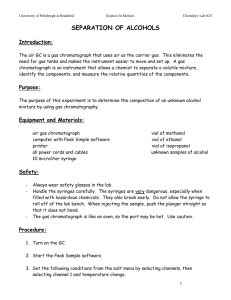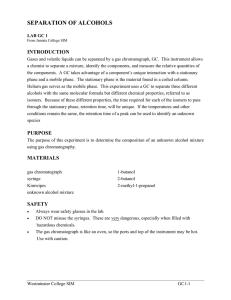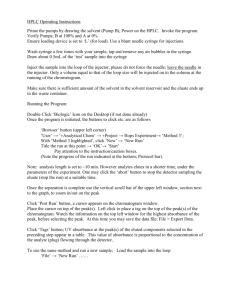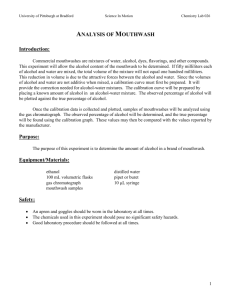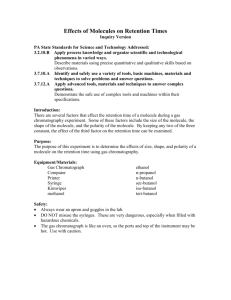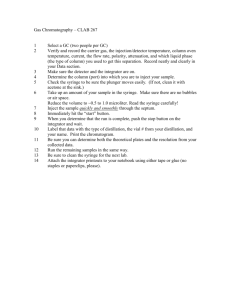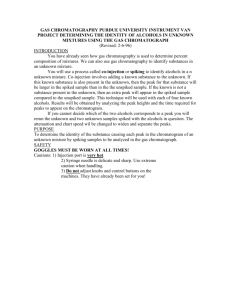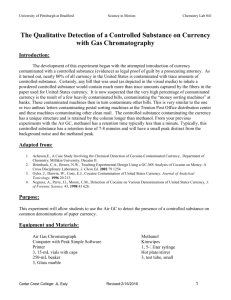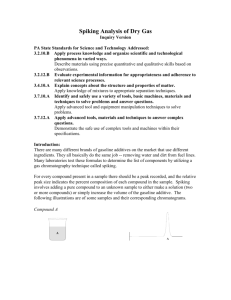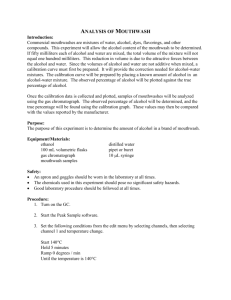#20 Separation of Alcohols Using Gas Chromatography
advertisement
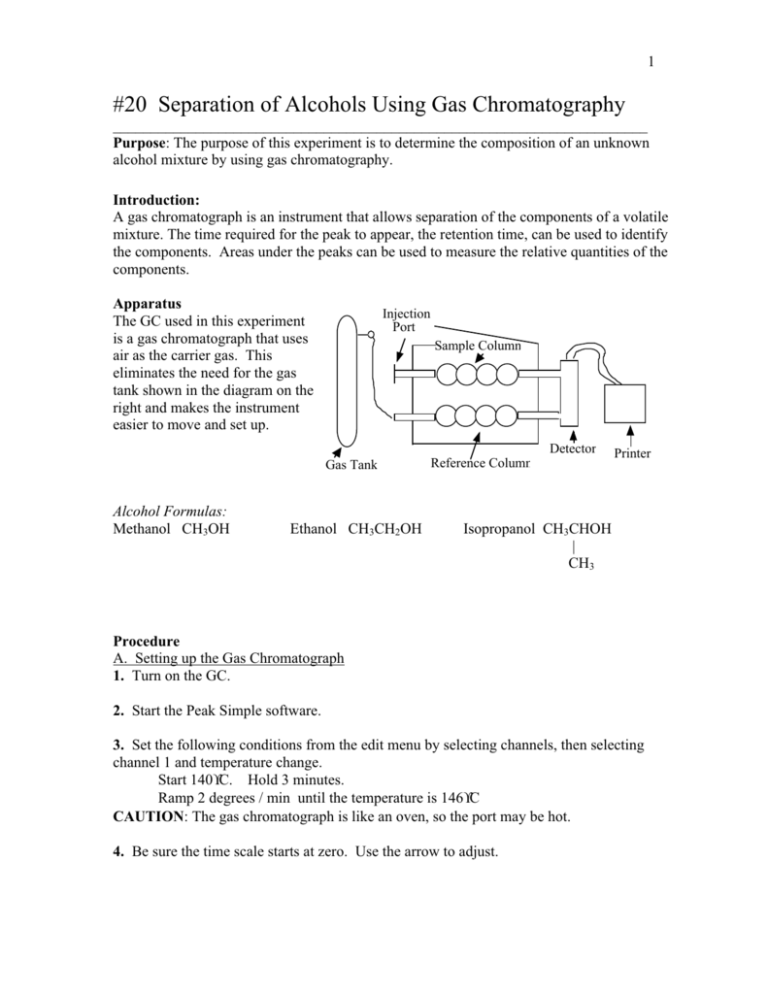
1 #20 Separation of Alcohols Using Gas Chromatography _______________________________________________________________________ Purpose: The purpose of this experiment is to determine the composition of an unknown alcohol mixture by using gas chromatography. Introduction: A gas chromatograph is an instrument that allows separation of the components of a volatile mixture. The time required for the peak to appear, the retention time, can be used to identify the components. Areas under the peaks can be used to measure the relative quantities of the components. Apparatus The GC used in this experiment is a gas chromatograph that uses air as the carrier gas. This eliminates the need for the gas tank shown in the diagram on the right and makes the instrument easier to move and set up. Injection Port Sample Column Detector Gas Tank Alcohol Formulas: Methanol CH3OH Ethanol CH3CH2OH Reference Column Printer Isopropanol CH3CHOH | CH3 Procedure A. Setting up the Gas Chromatograph 1. Turn on the GC. 2. Start the Peak Simple software. 3. Set the following conditions from the edit menu by selecting channels, then selecting channel 1 and temperature change. Start 140°C. Hold 3 minutes. Ramp 2 degrees / min until the temperature is 146°C CAUTION: The gas chromatograph is like an oven, so the port may be hot. 4. Be sure the time scale starts at zero. Use the arrow to adjust. 2 B. Running Known Alcohols 1. Obtain a microliter syringe and a vial of a known alcohol standard. 2. Clean the syringe. With the plunger fully depressed, place the needle into the alcohol sample. Slowly draw up the plunger to obtain a sample of alcohol in the syringe. Remove the syringe from the alcohol sample. Discharge this sample into a waste container. Repeat 6 times. CAUTION: Syringes break easily, so handle them very carefully. 3. Draw 1 microliter of air into the syringe. Place the clean syringe needle back into the alcohol sample and measure 1 microliter of the standard alcohol, and then draw another microliter of air into the syringe. Wipe the needle with a Kimwipe. 4. Click on the θ button on the run screen to zero the current. 5. Insert the needle carefully into the injection port of the GC until the needle stops. CAUTION: When injecting the sample, push the plunger straight so that it does not bend. 6. Inject the sample, and start the data collection simultaneously by depressing the syringe plunger and removing the syringe and pressing the space bar on the computer at the same time. 7. When the sample peak of a standard returns to baseline, the run may be stopped by pressing the end button on the computer. 8. After the peak is obtained, record data and print the graph as instructed. 9. Repeat steps 1-8 for the other two known alcohols. C. Running Unknown Alcohol Mixture 1. Obtain an unknown sample and record number. 2. Repeat steps above used for the known samples. When running the unknown sample, be certain to let the data collect long enough to get all possible peaks. Record data. 3. Identify alcohols present by comparison with retention time of known alcohols. 4. To find the % of each alcohol in the sample: a) Record the area of each peak in the unknown. b) Record the total area. c) % alcohol = area under the alcohol peak total area 3 Data and Results (GC and Alcohols) Name(s) ______________________________________________________________ A. Setting up the Gas Chromatograph Starting temperature Holding time Ramping rate Final temperature Data collection duration B. Running Known Alcohols Standards Retention time (min) Methanol Ethanol Isopropanol C. Running Unknown Alcohol Sample Unknown number__________________ Unknown Sample Peak 1 Peak 2 Peak 3 Total Retention Time Alcohol Area % 4 Questions: 1. Why was it necessary to run known samples of possible components in the unknown mixture? 2. If a sample is properly injected into the gas chromatograph and several peaks are observed, what can be concluded about the sample? 3. Why is it important to clean the syringe between samples? 4. Why is it important to wipe the needle before injecting the sample into the instrument? ___________________________________________________________________________ 5 Instructor’s Guide (GC and Alcohols) Data and Results Lab Time: 45 minutes A. Setting up the Gas Chromatograph Starting temperature 140 °C Holding time 3 min Ramping rate 2 °C / min Final temperature 146 °C Data collection duration 6 min B. Running Known Alcohols Standards Retention time (min) Methanol 0.583 Ethanol 1.366 Isopropanol 2.566 C. Running Unknown Alcohol Sample Unknown number__________________ Unknown Sample Retention Time Alcohol Area % Peak 1 0.666 Methanol 1998 29.95 Peak 2 1.550 Ethanol 2252 33.75 Peak 3 3.033 Isopropanol 2422 36.30 6672 100 Total 6 Answers to Questions: 1. Why was it necessary to run known samples of possible components in the unknown mixture? This was necessary to determine the retention times in order to identify the components in the unknown mixture. 2. If a sample is properly injected into the gas chromatograph and several peaks are observed, what can be concluded about the sample? It contained some volatile impurities. 3. Why is it important to clean the syringe between samples? Any trace of the previous substance will be detected by the gas chromatograph and produce an additional peak. 4. Why is it important to wipe the needle before injecting the sample into the instrument? If any sample is on the outside of the needle it will be vaporized and travel through the column before the sample is injected, thus producing double peaks. ___________________________________________________________________________ Equipment and Materials: Items Number air gas chromatograph 1 computer 1 Peak Simple software - printer 1 power cords and cables - 10 microliter syringe Comment Installed on the computer. Attached onto GC. 3-6 ethanol 20 mL 1 vial isopropanol 20 mL 1 vial methanol 20 mL 1 vial unknown alcohols 20 mL 1 vial waste container 1 CAUTION: The GC column must never be heated, even briefly, above its maximum recommended operating temperature of 150 °C. Any sample injected into the GC must contain only volatile materials. 7
